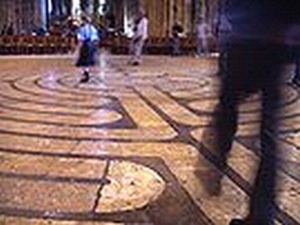A labyrinth is circular or spiral in shape, with a single, circuitous path that leads into – and out of – the center.
Labyrinths differ from mazes, which have multiple entrances and paths. Dating back thousands of years, labyrinths are found world-wide in many cultures.
Labyrinth walking is a practice used globally for meditation, prayer and healing by individuals, and in churches, hospitals and other institutions such as the Veterans Administration.
Master labyrinth builder Robert Ferre’ built a labyrinth at a VA facility in Marion, Indiana that is used by veterans, as well as other labyrinth walkers who travel far and wide to walk it.
 Labyrinth walking is a simple process:
Labyrinth walking is a simple process:
A person walks on the spiral path that leads from the outside of the labyrinth to the center, and then back out on the same path. The center of the labyrinth is always visible to each walker – there is no need to figure out how to get to the center, as with a maze. As a result, walkers can free the mind for “walking meditation”.
In the late 1970’s, ground-breaking research in mind/body connections by Harvard researcher & physician Dr Herbert Benson showed that physical activities such as walking and meditation can permanently improve conditions such as anxiety, high blood pressure and insomnia.
The action of mindfully walking on a path literally calms both body and mind, generating what Benson named the “Relaxation Response”. Today, the global popularity of labyrinth walking underscores its beneficial effects – experienced by persons of all ages and abilities.
Rebecca has been walking on labyrinths and using them in her art since experiencing her first walk while in college on the iconic ancient labyrinth on the floor of the Cathedral of Our Lady, in Chartres, France. She makes limited edition prints and glass works featuring the Chartres Labyrinth.
She is trained as a Certified Veriditas Labyrinth Facilitator, and is a member of The Labyrinth Society, two international groups which promote labyrinth walking and education.

I am interested in the practise of placing Labyrinths in the public domain as a visual statement and the interaction with the same labyrinths by the local community and passing people.
I would value information and learning of any research that has been conducted in this area.